This is topic Vinegar questions in forum 8mm Forum at 8mm Forum.
To visit this topic, use this URL:
https://8mmforum.film-tech.com/cgi-bin/ubb/ultimatebb.cgi?ubb=get_topic;f=1;t=011335
Posted by Chad Shumaker (Member # 2384) on March 11, 2017, 08:41 PM:
To begin with- apologies. This is a topic that seems to stir up lots of debate, but I want some advice.
I have three films (5 reels in all) that have a faint vinegar smell to them. All have been cleaned with Filmrenew, dried, and let to "air out" for a few days. They are also stored with filter packs (courtesy of Steve at the US Reel Image)in the boxes. The boxes are currently stored away from the rest of my collection.
I read a few months back that certain types of film cannot get Vinegar and that the way to test this was to hold them up to a very bright light. If you can "see through" the film it is a "safe print"- at least that was my understanding.
So, here are my reels against a bright light. The hand/fingers belong to my lovely and patient wife.
Here is Taxi Driver
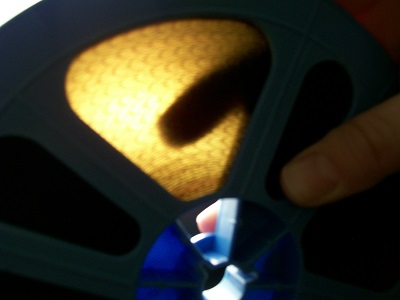
These three are The Dirty Dozen
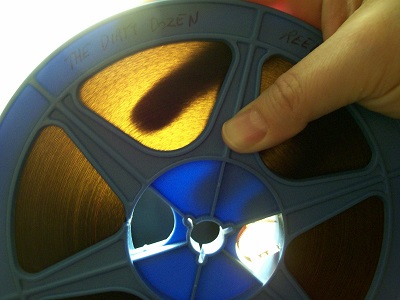
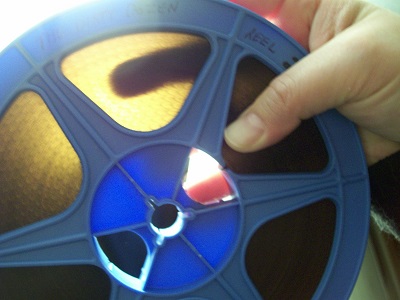
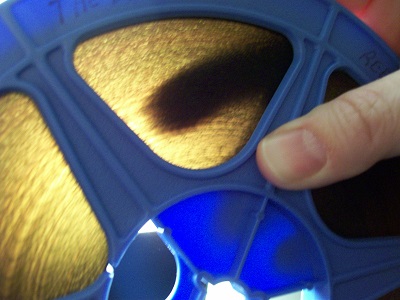
And finally The Exorcist
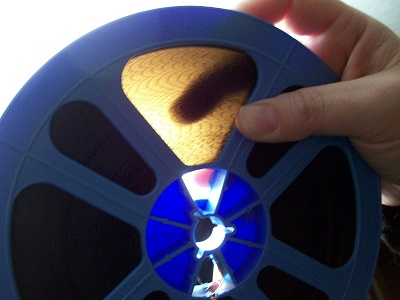
Are these films safe to store with the rest? Thanks a bunch!
Posted by Winbert Hutahaean (Member # 58) on March 11, 2017, 09:17 PM:
Hi Chad,
I have never heard about "can see through the film under the very bright light" rules, so I cannot give any comment.
But what I knew there are two type modern film base, i.e Acetate and Polyester (mylar) with Polyester is said to not get vinegar.
How we know it is acetate or poly? we must tear it. If it can be easily cut with our fingers, then it is acetate.
You cannot do the same with poly film only with scissors/cutter.
Cheers,
Posted by Steve Klare (Member # 12) on March 11, 2017, 09:46 PM:
That golden color indicates a polyester film base. Acetates are basically black in this test.
-so you should be good to go!
Posted by Chad Shumaker (Member # 2384) on March 11, 2017, 10:32 PM:
Winbert & Steve-
Thank you both for the replies!
Winbert- OK- sounds ridiculous me saying it, but by tearing do you mean pulling apart or by gently twisting the film as you would tear a sheet of writing paper? I know, I know, tearing is tearing but couldn't any film like this be torn if I twist enough?
And Steve- if the gold color denotes polyester, is there any way to get that vinegar smell out at all? Did it just pick it up from other films it may have been stored with?
Posted by Steve Klare (Member # 12) on March 11, 2017, 11:44 PM:
I've had a poly print show up stinking of vinegar. It was a used print that came from Derann themselves.
(I threw a fit! They calmed me down.)
I think it had come from some collection that also had vinegared acetate prints and the smell got into the cardboard boxes. After a while it aired out, and maybe 12 years down the road it is still good.
Acetate base has the acetic ion, which is also part of acetic acid, which is vinegar.
Polyester is an entirely different chemical.
Who knows: maybe polyester can degrade into a leisure suit, but I've never seen it happen! ![[Wink]](wink.gif)
Posted by Patrick Feuerstein (Member # 5293) on March 12, 2017, 04:14 AM:
If the smell is not too important I've a trick.
Put you reels in a plastic box like Tupperware with a grid in the bottom. Under that grid place a dry piece of blotting paper (or paper towel). No metal parts in the box to avoid oxydizing. Close the box and wait a few weeks. I used this trick and it works.
A vinegar bi-acetate could be difficult to cut by hand (like a polyester).
Good luck
Patrick
Former Film archivist-restorer
Posted by Winbert Hutahaean (Member # 58) on March 12, 2017, 04:38 AM:
Chad,
Yes tearing it like you do with paper. Indeed your film will be torn if you do this. So do it on the film tail or leader. After it get torn you can cut it out.
Anyway I say this just to let you know what is acetate vs poly. Later you will be an expert and can distinguish it with your bare eyes.
As poly base will not get vinegar syndrome, you may get tricked by chemical smell that was used to process the film. It is similar. But the more you are involved with films you can distinguish the different.
If you still can find a film lab in your city (to process still photo), smell it...that is the smell of chemical that is not vinegar. Hence your film is safe.
Visit www.film-tech.com for free equipment manual downloads. Copyright 2003-2019 Film-Tech Cinema Systems LLC

UBB.classicTM
6.3.1.2
![[Wink]](wink.gif)